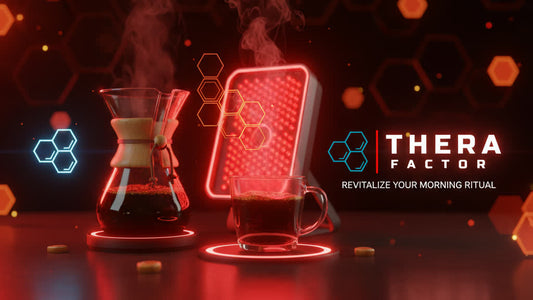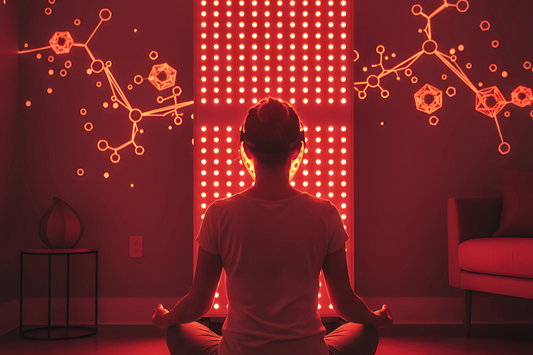
Red Light Therapy vs. Sun Exposure: Understand the Differences, Benefits, and Risks
Share
Introduction
With the growing interest in natural, non-invasive solutions for well-being and health, red light therapy has gained prominence as an effective option for a variety of conditions. Often compared to sun exposure, this form of phototherapy raises questions about the differences between the light emitted by the sun and by therapeutic panels, such as those in the TheraFactor® TheraPRO line . This article explores in depth the differences between both light sources, their spectra, their effects on the body, and the risks and scientifically proven benefits.
What is Red Light Therapy?
Red light therapy ( also known as photobiomodulation) is a non-invasive treatment that uses specific wavelengths of red and near-infrared (NIR) light to stimulate cellular activity, promote tissue regeneration, reduce inflammation, and relieve pain.
How does it work?
Studies show that light with wavelengths between 630 nm and 1060 nm penetrates the skin and reaches mitochondria , where it stimulates the production of ATP (adenosine triphosphate) , the primary source of cellular energy. This activation improves cellular function, accelerates recovery, and reduces pain.
Spectra Used in TheraFactor®
The TheraPRO line uses advanced technology with the following spectrums:
- Visible red : 630 nm, 650 nm, 660 nm, 670 nm
- Near Infrared (NIR) : 810 nm, 830 nm, 850 nm, 1060 nm
These spectrums are proven effective for therapeutic purposes, and TheraFactor® devices utilize DualPRO+ Chip 5W , precise emission, Ultra-Low EMF & ELF , and independent spectrum control via app .
Sunlight: A Natural and Complex Source
Sunlight is composed of a wide range of spectra, from ultraviolet (UV) light, through visible light, to infrared:
- UV light (100–400 nm) : Important for vitamin D production, but with associated risks (skin cancer, premature aging)
- Visible light (400–700 nm) : Includes blue, green, and red light
- Infrared (700 nm – 1 mm) : Generates heat, but not specific therapeutic stimulus
While sunlight is beneficial in small doses, it is often associated with cumulative risks from prolonged exposure .
Key Differences Between Red Light Therapy and Sunlight
| Feature | Sun | Red Light Therapy |
|---|---|---|
| Power source | Natural | Technological |
| Emitted spectra | UV, visible, infrared | Red and NIR |
| Benefits | Vitamin D, circadian rhythms | Regeneration, anti-inflammatory, pain |
| Risks | Burns, cancer, photoaging | Non-invasive, no excessive heat |
| Exposure control | Difficult (varies with weather/time) | Fully controllable |
Domestic Use of Red Light Panels
One of the great advantages of red light therapy is its ease of use at home . TheraFactor® TheraPRO panels are designed to adapt to different routines and needs:
- Apply to localized areas (e.g. back, knees, joints)
- Full body sessions , with vertical supports
- Integration with physiotherapy, yoga or meditation routines
- Use with remote control APP and custom profiles
It is recommended to use 10 to 20 minutes per session , 3 to 5 times a week, depending on the therapeutic objective.
Scientific Studies: Proven Benefits
The effectiveness of red light therapy is well documented in several studies:
1. Reduction of chronic pain
- A study published in Pain Research and Management (2017) showed a significant reduction in pain in patients with arthritis and low back pain.
- Link: https://www.ncbi.nlm.nih.gov/pmc/articles/PMC5738682/
2. Muscle recovery
- The Journal of Biophotonics (2016) revealed that athletes who used red light had faster muscle recovery.
- Link: https://pubmed.ncbi.nlm.nih.gov/27159403/
3. Treatment of seasonal depression (SAD)
- Harvard Health Publishing reported improvements in SAD symptoms with red light.
- Source: https://www.health.harvard.edu/blog/
4. Healing and regeneration
- Photomedicine and Laser Surgery (2014) demonstrated significant improvement in tissue regeneration.
- Link: https://pubmed.ncbi.nlm.nih.gov/24665973/
Contraindications and Precautions
While red light therapy is safe for most people, there are some contraindications and precautions :
- Pregnancy (without medical approval)
- Photosensitive epilepsy
- Use of photosensitizing medications
- Active or under treatment cancers (must be assessed on a case-by-case basis)
It is always recommended to consult a healthcare professional before starting any type of treatment.
Red Light in Pain Treatment
Red light therapy has shown very positive results in managing chronic pain and inflammation . Mitochondrial stimulation leads to increased cellular energy production, improved tissue oxygenation, and a reduced inflammatory response. Results are visible in conditions such as:
- Rheumatoid arthritis
- Lower back pain
- Fibromyalgia
- Tendonitis
These effects are particularly effective when used regularly.
Advantages of the TheraFactor® TheraPRO Line
TheraFactor® is a pioneer in Portugal in the production of high-performance photobiomodulation equipment. TheraPRO panels stand out for:
- Precise emission in R+|NIR+ spectra
- 5W DualPRO+ Chip Technology
- Independent control of wave spectra
- Custom profiles and APP with remote control
- Irradiance power ≥175mW/cm2
- Premium design and highly durable materials
CAUTION: Conventional light panels lack the power or wavelength needed to activate mitochondria. TheraFactor® TheraPRO Panels use high-precision dual diodes, shielded from EMF, with precise emission in the therapeutic range.
Conclusion
Sun exposure and red light therapy offer distinct benefits, but TheraFactor® panel therapy offers a safe, effective, and controlled solution for obtaining the benefits of light without the risks of UV radiation. With solid scientific support, it's an excellent option for those seeking pain relief, cellular regeneration, and overall well-being.
Explore the TheraPRO range at www.therafactor.eu and experience the light that transforms.







